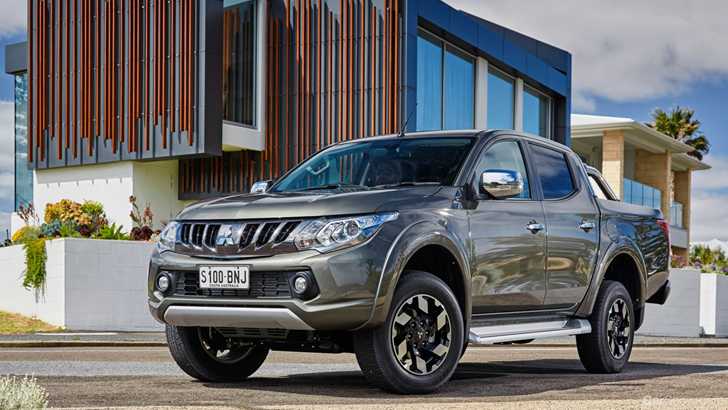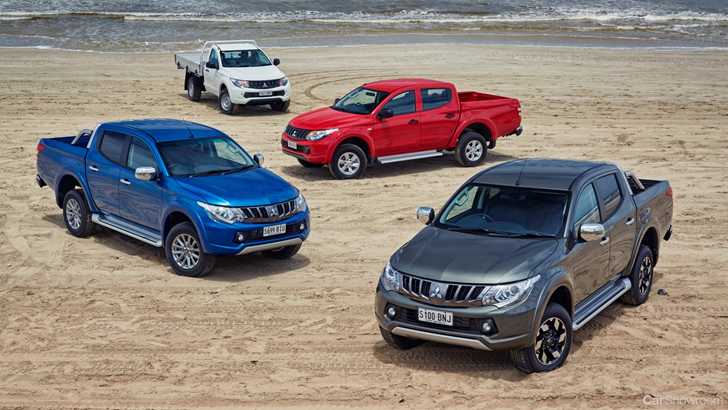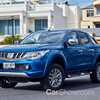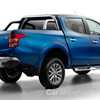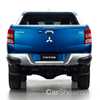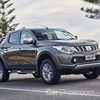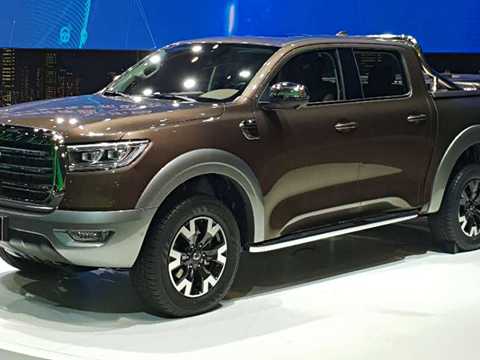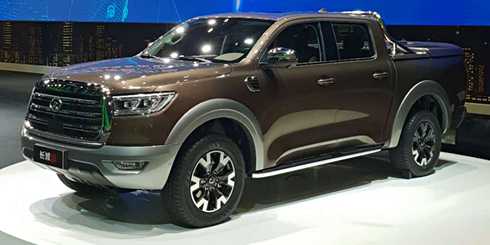The Triton proves you can be stylish and value-driven at the same time.
We don’t have to talk about the popularity of utes in our market. The utility is as synonymous with Australia as a certain vegetable spread, and as such, manufacturers clamber to bring the very best utes they have to offer to our shores. Australia is one of the most ute-centric markets in the world, making our market a dealmaker (or deal breaker) for many.
What’s surprising is that some of the more popular options abroad don’t seem to carry the same momentum in our market. Take the Mitsubishi Triton, for example. Though sales have been healthy, it lags behind competitors by a large margin, despite offering great value and capability. We suspect the redesign of the Triton in 2015 got pushed to the sidelines as the competition brought in all-new models, and as a result, the Triton remains a relative underdog in the segment.
Is that entirely deserved, though? On the surface, not really. The Triton’s value argument is a truly solid one, offering as much as $10,000 off comparably-specced rivals, and the 2.4-litre MIVEC turbodiesel is rather impressive. Couple that with a roomy interior and a market-specific suspension tune, and we’re left wondering why it doesn’t sell in stronger numbers.
Exterior
“While the styling might polarise, as it has for some time, the new Triton certainly isn’t the ugliest dual cab on the market.” - CarAdvice
A design revision in 2016 saw the Triton go from ‘a little old’ to ‘rather refreshing’ overnight. This isn’t a brand-new car, so much as an extensive facelift. You can barely tell what remains of the old car, and that’s rather the point. That said, some of the changes have been rather divisive, like the chrome-heavy nose that never fails to draw an opinion.
The Triton remains one of the sleekest utes in its class, and boasts great aerodynamics and lower wind noise as a result. It isn’t quite as boastful of its air-bending skills as the Nissan Navara (with its pseudo-spoiler on the tailgate), but it’s pretty good. The Triton remains as one of the more compact offerings in the segment though, with a short wheelbase and decent overhangs on either end making up for the lack of distance between the hubs.
Despite the redesign, certain distinctive elements remain. The ‘J’ line that outlines cab from bed is retained, as well as the unique windowline. It might not be as handsome as the Volkswagen Amarok, or quite as brash as the Ford Ranger, but the Triton appeals to a very specific sort of buyer who wants to stand out, but not for the same reason as everyone else.
Engine & Drivetrain
“With an all-aluminium cylinder block and other lightweight materials, the Euro 5 compliant engine is more efficient, powerful and refined than its predecessor.” - CarsGuide
The Triton is relatively simple in this regard. There is only one engine on offer, a 2.4-litre MIVEC turbodiesel, with 133kW of power and 430Nm of torque. Power is sent to all four wheels by either a five-speed automatic or a five-speed manual, though we feel that the automatic transmission works best here. While it may be a ratio behind some rivals, the automatic gearbox is slick, and its shifts are executed deftly.
The 2.4-litre turbodiesel may be smaller than some rivals on paper, but we can assure you that there’s no performance deficit. Not only is it frugal on fuel (7.6L/100km is claimed on top-spec Exceed models with the automatic gearbox), but it also sheds any suggestion of gruffness that may have been inherited from the older models. It’s quiet and well-behaved, and with that automatic gearbox, always on song when you need the power. It’s got a half-decent engine note too, so full-throttle sprints won’t be grating.
Interior
“The interior of the Triton is a little bit basic and unassuming, but it’s also reassuringly solid and well put together.” - Unsealed 4X4
If you’ve sat in a Mitsubishi passenger car lately, you’ll find very little difference between that and the Triton. This particular ute offers the most car-like interior to date, completely bereft of the sort of minor design flourishes that mark out a cabin as one that belongs to a ute. While that also means the cabin architecture errs on the side of boring, it’s far from inoffensive, and that’s always a good thing.
While it may lack visual appeal, the Triton’s cabin is as solid as they come. Forget withstanding the daily rigours of family life, the interior feels like it’s built to haul building materials in here rather than in the tray. As such, it lacks the sort of soft-touch materials that you’d find in most passenger cars, and that’s likely going to be the only reminder you’re in a ute. It isn’t unpleasant, just utilitarian. In a ute, surely, that doesn’t surprise you.
Behind the Wheel
“Tarmac driving proved to be an area where the Mitsubishi really shone. Not only is it really quiet (by most double-cab [utility] standards), but the ride quality is comparatively excellent.” - Cars South Africa
Owing to their dimensions, utes aren’t known for being the best steers out there. Of course, there are exceptions to the rule (like the Ford Ranger and Volkswagen Amarok) which can feel more sprightly than you might expect, and the Triton is broadly similar. Body roll is very well controlled (especially compared to the old model), but comfort isn’t compromised as it happily soaks up surface imperfections deftly. Of course, an empty tray will lead to some rear-end bounce, but that’s easily remedied with a little weight.
The MIVEC 2.4-litre is an all-new block, and was designed while keeping in mind that emissions-based taxation may be a part of the not-to-distant future. As a result, the Triton only emits 170g/km (thereabouts) of CO2, which puts its emissions far lower than some of its contemporaries. The MIVEC unit is also rather refined, with very little rattling and shaking that you’d usually find from a turbodiesel ute.
The five-speed automatic gearbox also works very well, selecting the right gear for the right time. It holds on to ratios a little longer when it has to, but isn’t shy about shifting into 5th when cruising. Though some may moan about the lack of a sixth forward ratio, we argue that the 5-speed unit in the Triton is so well engineered, we’d rather have this than a quickly-made 6-speeder any day.
Safety & Technology
“Unlike some multi-role utes, the Triton’s safety features are consistent across the model range, even for the more basic single-cab work trucks.” - WhichCar
Utes have, of late, paid increasingly more attention to safety technology than ever before, in light of a lot of them being used more as passenger cars rather than outward utility vehicles. As such, the Triton packs an impressive seven airbags, as well as electronic stability control. Double-cab models (the most popular body style for those intending to utilise their utility as a family car) also get reversing cameras as standard.
Higher spec models like the GLS and Exceed offer permanent all-wheel drive capability, which allows drivers to benefit from extra traction during more challenging conditions. As such, the Triton range was given a full five-star ANCAP rating in April 2015.
Verdict
The Mitsubishi Triton, as a ute, teeters between the outright utility of some and the comfort & plushness of others. While some of its competition (like the Volkswagen Amarok) appear as more of a car-like package, and others more workhorse-oriented (like the GWM Steed), the Triton balances the need for utility and the desire for refinement really rather well. The new all-aluminium MIVEC engine is an absolute gem, offering great performance, refinement, and fuel economy despite being smaller in outright capacity than some of its rivals. The five-speed automatic is noteworthy too, for its smooth shifts and deft choice of ratios.
The Triton will appeal to every kind of ute buyer, aided further by its wide range of body styles. You can rest assured though that whichever Triton might tug at your heartstrings, its rugged reliability and unflappable dependability will see you right for a very long time, indeed. Couple that with the great value offered across the range, and the Triton will very easily make the shortlist for plenty of ute buyers.
CarAdvice - 7.0/10 - “There’s no doubt that the 2016 Mitsubishi Triton is the best Triton you’ve ever been able to buy. It’s a significant step forward from the outgoing model especially in terms of refinement and interior ambience. Despite that, the new Triton isn’t the segment leader. For our money, the Ford Ranger is still the pick of the current high-spec dual cab brigade while the Volkswagen Amarok remains the refinement leader especially on road.”
WhichCar - 4.0/5.0 - “The first all-new Mitsubishi Triton in 10 years feels nearly as refined as a good passenger car, and for a ute it is easy to drive in town. Its diesel engine is modern and easy on fuel, and all Tritons, even the single-cab work trucks, are strong on safety. The most expensive Tritons offer excellent smartphone integration.”
CarsGuide - 4.0/5.0- “In the terms of former federal treasurer Joe Hockey, the facelifted Mitsubishi Triton is a lifter not a leaner. The Mitsubishi workhorse has been loaded up with kit and commercial vehicle characteristics, all of which it carries off with aplomb; no dragging the feet here.”
Unsealed 4X4 - 4.0/5.0 - “The Triton doesn’t have the bigger engines and performance figures of other utes; nor does it have as much off-road clearance. But it’s a ute without any obvious weaknesses. The engine performs well. And where the Triton really beats all comers is: Price.”
Cars.co.za - 4.0/5.0 - “The combination of driving refinement and refined new engine make a compelling case for the [ute] enthusiasts. Sure, it’s going to be really difficult to tempt the Hilux and Ranger loyalists to switch to Mitsubishi, but for those who want something new, different and, crucially, cheaper, the Triton presents terrific value.”
CarsApproved - 4.0/5.0 - “The Mitsubishi Triton is the Japanese carmaker’s compact pick-up in this ever more popular class. Launched as the ‘Forte’, the Triton emerged in the mid-80s and it is now regarded as one of the sportiest options among what are otherwise commonly regarded as ‘workhorse’ vehicles. Updates are minimal, but they all make a great car just a little better.”
Wheels Magazine - 6.4/10 - “Simply being the best drive in class doesn’t automatically make a car a best-seller, but brilliant value for money is a sure-fire way to make an impression on buyers. And that’s Mitsubishi’s approach with the Triton.”
AutoExpress - 4.5/5.0 - “While the Mitsubishi [Triton] for sale today hasn’t quite achieved the iconic status of the Toyota Hilux, Mitsubishi’s 4x4 [ute] has earned a legion of its own fans around the world. There are any number of tough, stylish, and often luxuriously-equipped rivals for the [Triton] of course; However, in terms of its driving refinement, efficiency, performance and load capacity, the Mitsubishi [Triton] sets the bar very high for its rivals.”

